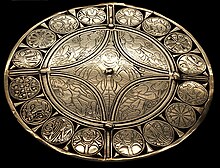Fuller Brooch
| Fuller Brooch | |
|---|---|
 Fuller Brooch as displayed in the British Museum | |
| Material | Silver and niello |
| Size | 11.4 cm in diameter |
| Created | Late 9th Century AD |
| Present location | British Museum, London |
| Registration | M&ME 1952,0404.1 |

The Fuller Brooch is an
Description
The brooch is a large disc made of hammered sheet
Style and materials
Stylistically it is "in a very late version of the
History of ownership
The brooch has survived in excellent condition, although the pin and its attachments have been removed, and the top of the brooch has been perforated for suspension, and it may be the only surviving piece of secular Anglo-Saxon metalwork to remain unburied since its creation. It was thought to be a fake by Sir Charles Hercules Read, Keeper of British and Medieval Antiquities of the British Museum, because of its excellent condition. He advised the Ashmolean Museum in Oxford which had been lent the brooch, to take it off display. It was then bought by Captain A. W. F. Fuller for the price of the silver. In 1952 Capt. Fuller donated the brooch to the British Museum on the condition that it henceforth be called the Fuller Brooch.[7][8][9]
References
- D. G. Hogarth to accept the loan. On the advice of the then Keeper of British and Medieval Antiquities at the British Museum (Sir Hercules Read, P.S.A.) and his assistant keeper (R. A. Smith) the brooch was pronounced a fake and withdrawn from exhibition with the approval of the Ashmolean Museum's technical specialist, W. H. Young. The brooch was eventually purchased by Capt. A. W. F. Fuller and, apart from occasional mentions (e.g. by Sir Alfred Clapham), was not thought of seriously until the Strickland brooch (registration no. 1949,0702.1) was brought to the British Museum. On the advice of Sir Thomas Kendrickthe Fuller brooch was traced by Mr. Bruce-Mitford and after laboratory examination it was acquired by the British Museum.
- doi:10.2307/4422395– via JSTOR.
- ^ Janina Ramirez (2010-08-12). "Treasures of the Anglo Saxons, Decoding the Fuller Brooch". BBC. Archived from the original on 2011-02-02. Retrieved 2011-02-05.
- ISBN 9780714128092
- ^ Moss, A.A., Studies in Conservation, vol. ii, 179
- doi:10.2307/20209242– via JSTOR.
- ^ Trustees, British Museum. (1952), The British museum quarterly, Volume 17, Trustees of the British Museum, p. 75
- ^ Harden, Donald Benjamin (1956), Dark-age Britain, Taylor & Francis, p. 174
- ^ British Museum Collection
External links
- The Fuller Brooch - The British Museum
